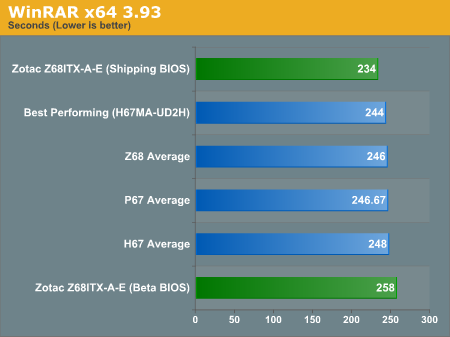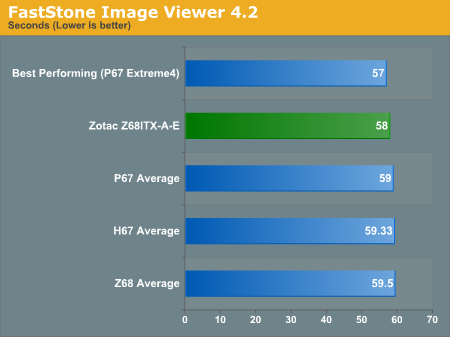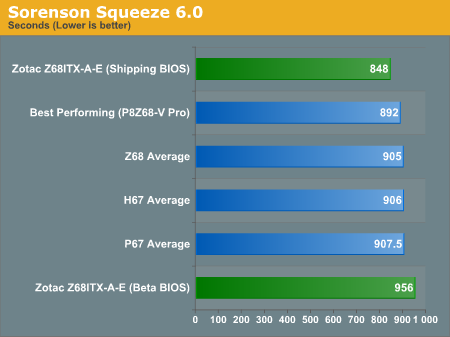Zotac Z68ITX-A-E Wifi Review - Mini-ITX meets Z68
by Ian Cutress on September 22, 2011 10:01 AM EST- Posted in
- Motherboards
- Mini ITX
- ZOTAC
- Z68
3D Movement Algorithm Test - link
The algorithms in 3DPM employ both uniform random number generation or normal distribution random number generation, and vary in various amounts of trigonometric operations, conditional statements, generation and rejection, fused operations, etc. The benchmark runs through six algorithms for a specified number of particles and steps, and calculates the speed of each algorithm, then sums them all for a final score. This is an example of a real world situation that a computational scientist may find themselves in, rather than a pure synthetic benchmark. The benchmark is also parallel between particles simulated, and we test the single thread performance as well as the multi-threaded performance.


The Zotac board is the outright winner in our 3DPM benchmark testing at stock. Predictably, in the multithreaded scenario, it comes out top because of the turbo issue, resulting in four threads at 3.7 GHz, whereas the other results have four threads at 3.4 GHz.
WinRAR x64 3.93 - link
With 64-bit WinRAR, we compress the set of files used in the USB speed tests. WinRAR x64 3.93 attempts to use multithreading when possible.

Again, the Zotac takes a distinct first place here due to that turbo boost design 'feature' and that WinRAR is a multi-threaded benchmark.
FastStone Image Viewer 4.2 - link
FastStone Image Viewer is a free piece of software I have been using for quite a few years now. It allows quick viewing of flat images, as well as resizing, changing color depth, adding simple text or simple filters. It also has a bulk image conversion tool, which we use here. The software currently operates only in single-thread mode, which should change in later versions of the software. For this test, we convert a series of 170 files, of various resolutions, dimensions and types (of a total size of 163MB), all to the .gif format of 640x480 dimensions.

As FastStone is a single threaded benchmark, the Zotac does not take top honors this time, but still performs rather well.
Sorenson Squeeze 6.0 - link
Sorenson Squeeze is a professional video encoder, complete with a vast array of options. For this test, we convert 32 HD videos, each a minute long and approximately 42 MB in size, to WMV 512KBps format. Squeeze can encode multiple videos at once, one for each thread.

In multithreaded mode, the Zotac board takes an average 50 seconds quicker to process our Squeeze test workload than almost every other board.










29 Comments
View All Comments
dac7nco - Thursday, September 22, 2011 - link
I think at this point Zotac has proven that they either don't care about proper MB design, or they just don't care. ASRock has a cheap mITX Z68 board... what was the problem in reviewing that? The fact that a reputable place like Anandtech goes anywhere near Zotac's boards makes me wonder.Daimon
EnzoFX - Thursday, September 22, 2011 - link
I agree, Zotac boards are overrated and overpriced. They care more about how their specs look on paper. Not a brand I'd recommend or read about in a review =P, unless they seriously step things up in regards to their BIOS and reliability.Ananke - Thursday, September 22, 2011 - link
I completely understand that this is a great, feature full board. However, in my sole opinion, it is too expensive for the targeted market. Why would somebody use this plus at least a $100 processor for a HTPC, when the same can be done with $300-$400 budget laptop /which comes with the Win OS btw/, or less than $100 AMD E-350 setup?Good for the consumer, since it offers a choice. I guess the same type of people who buy BMW Mini - an expensive pretend-to-be sport car, would buy this too.
DaveSimmons - Thursday, September 22, 2011 - link
The target is a small-form-factor _gaming_ PC not a simple HTPC -- for a HTPC you don't need Z68 to allow overclocking am i5-2500K. For pure HTPC use a H61/H67 motherboard and possibly nothing more than a socket 1155 Pentium CPU is enough.I wouldn't buy one that always runs my CPU out of spec though.
Ananke - Thursday, September 22, 2011 - link
Dave, small form factor gaming PC is an oxymoron. Where are you going to put a high end GPU card on this board? Playing WoW on integrated graphics is not "gaming" for God's sake. Hence my thought, for $170 this board is worthless. It might be interesting if it costs $70 or less.Mr Perfect - Thursday, September 22, 2011 - link
People build plenty of small form factor gaming PCs. Get yourself a Silverstone Sugo 5 or 7 case and you can put any dual slot card you want in it.Breathless - Thursday, September 22, 2011 - link
You don't know what you are talking about. I have this very board in a Lian Li PC-Q08B with an Asus GTX 580 Direct CUii, 2600k, 8GB's of ram and several SSD's. It is fully acceptable to say I have a small form factor gaming PC.DaveSimmons - Thursday, September 22, 2011 - link
As they said, Silverstone and Lian-li both make SFF gaming cases for mini-ITX, and you can put a GTX 560 ti or AMD 6870 in all of them, or even a higher-end card in a couple of them.You can even buy prebuilt gaming systems from CyberPowerPC in the SG07 case (LAN Party EVO Mini).
Times change, your SFF knowledge is a little out of date.
Rick83 - Thursday, September 22, 2011 - link
Gigabyte has been doing something similar on their Cougar Point boards all summer (now the first BIOS versions fixing this are finally coming out)There, once you enabled XMP, the CPU was automatically overclocked and overvolted using, afaik, the same turbo-tweak as on this Zotac.
Not sure what they've been thinking.
TrackSmart - Thursday, September 22, 2011 - link
I understand the need to have comparable test conditions for testing the performance of motherboards. That being said, it would be interesting to many of us to see what you can realistically get away with (in terms of a gaming PC) using this form factor and a small form factor case to match... Running at stock speeds, when gaming, would a decent SFF case be able to keep up with the heat of a Z68 processor plus a mid-range GPU? What about an overclocked Z68 plus whatever the most powerful GPU that would fit the case? Is this a viable platform for that kind of computing power to begin with? If not, then the overclocking results aren't very relevant to your testing.Keep up the good work on the motherboard reviews. And if it seems feasible, maybe you could cover some of the questions above in a "SFF/Mini-ITX gaming system" article. The key question being whether a SFF gaming rig is an oxymoron.